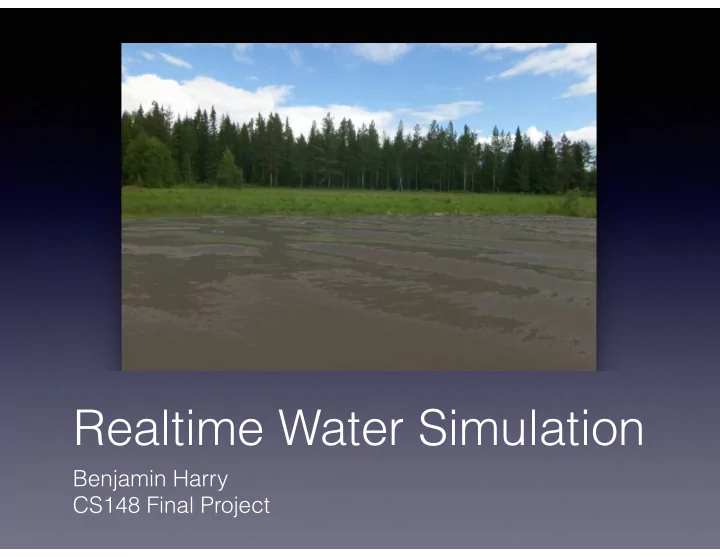

Realtime Water Simulation Benjamin Harry CS148 Final Project
Project Goal Create a realtime water simulation that exhibits characteristics of a real body of water. • Generate believable waves in realtime • Light reflection and transmission • Caustics on bottom surface
Relevance to Course Using OpenGL Lighting Effects: • Reflection - Fresnel Effect • Refraction - Snell’s Law
Implementing Waves Method for wave animation from Matthias Müller-Fischer. Initialized vertex heights for waves using sum of sines function. Initialize horizontal velocities to zero. For each time step update the vertex positions based upon forces acting on waves.
// Implementing the waves using height field. for all i, j { 2 * (u[i+1,j] + u[i-1,j] + u[i,j+1] + f = c 2 ; u[i,j-1] - 4u[i,j]) / h v[i, j] = v[i, j] + f * 𝝚 t; u new [i, j] = u[i, j] + v[i] * 𝝚 t; } for all i, j: u[i, j] = u new [i, j];
Height Field Conclusion Very easy to implement. Generated waves had decent animation, although could see triangles when looked closely. Data updated in CPU, which requires a lot of processing and copying data in for loops. Degraded frame rate.
Summing Sine Waves Sum sine waves with varying amplitudes, wavelengths, and directions to get height at each vertex. Need to also have the derivative to get the normal at each vertex. Perform the calculations in the GPU.
Summing Sine Waves Waves have "blobby" appearance. Sometimes sine wave shape is obvious (using random directions). Improved by adding high frequency normal map in the fragment shader.
Lighting Effects Reflections using OpenGL cube map feature. Improved the look of reflections using Fresnel effect. • Viewing angle affects how much light is reflected and transmitted. Caustics added using Snell's law and wave normals.
Challenges Figuring out which method to use to generate waves. • Overwhelming amount of information on the internet. • Implement wave calculations on CPU or GPU? Overcoming blobby appearance of waves. • Adding animated high frequency normal map.
References Bouny, Jeremy. "Realistic Water Shader for Three.js." GitHub. github.com/jbouny/ocean de Greve, Bram. "Reflections and Refractions in Ray Tracing." Nov 13, 2006. graphics.stanford.edu/courses/ cs148-10-summer/docs/2006--degreve-- reflection_refraction.pdf de Vries, Joey. Learn OpenGL. www.learnopengl.com Finch, Mark. "Effective Water Simulation from Physical Models." GPU Gems. 2004. developer.nvidia.com/gpugems/ GPUGems/gpugems_ch01.html
Guardado, Juan. "Rendering Water Caustics." GPU Gems. 2004. developer.nvidia.com/gpugems/GPUGems/gpugems_ch02.html Hollasch, Steve. Steve’s Web Pages. Nov 4, 2007. steve.hollasch.net/cgindex/render/refraction.txt Müller-Fischer, Matthias. "Fast Water Simulation for Games Using Height Fields." GDC 2008. matthias-mueller-fischer.ch/talks/ GDC2008.pdf Tessendorf, Jerry. "Simulating Ocean Water." 1999 - 2001. graphics.ucsd.edu/courses/rendering/2005/jdewall/ tessendorf.pdf
Recommend
More recommend